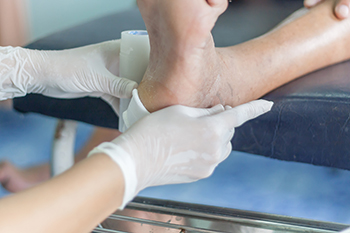April 2025
Why Live with Pain and Numbness in Your Feet?
Causes and Treatment of Pressure Ulcers

Pressure ulcers, also called bedsores, can develop on the feet, heels, or toes when constant pressure or shear forces restrict blood flow to the skin and underlying tissues. This often happens when people are confined to bed, use wheelchairs for long periods, or cannot move certain parts of their body. Shear forces, which occur when the skin moves in one direction while the bone moves in another can stretch or tear small blood vessels. Friction and moisture further weaken the skin, making ulcers more likely to develop. Older adults, people with foot deformities, poor circulation, or diabetes and kidney disease are more prone to developing these ulcers. A podiatrist can evaluate the depth and severity of the pressure ulcer and help manage it through proper wound care, debridement to remove dead tissue, and dressing selection. If you are suffering from painful pressure ulcers, it is suggested that you schedule an appointment with a podiatrist for a diagnosis and appropriate treatment.
Wound care is an important part in dealing with diabetes. If you have diabetes and a foot wound or would like more information about wound care for diabetics, consult with Dr. Lee R. Stein from Lake Shore Foot & Ankle, PC. Our doctor will assess your condition and provide you with quality foot and ankle treatment.
What Is Wound Care?
Wound care is the practice of taking proper care of a wound. This can range from the smallest to the largest of wounds. While everyone can benefit from proper wound care, it is much more important for diabetics. Diabetics often suffer from poor blood circulation which causes wounds to heal much slower than they would in a non-diabetic.
What Is the Importance of Wound Care?
While it may not seem apparent with small ulcers on the foot, for diabetics, any size ulcer can become infected. Diabetics often also suffer from neuropathy, or nerve loss. This means they might not even feel when they have an ulcer on their foot. If the wound becomes severely infected, amputation may be necessary. Therefore, it is of the upmost importance to properly care for any and all foot wounds.
How to Care for Wounds
The best way to care for foot wounds is to prevent them. For diabetics, this means daily inspections of the feet for any signs of abnormalities or ulcers. It is also recommended to see a podiatrist several times a year for a foot inspection. If you do have an ulcer, run the wound under water to clear dirt from the wound; then apply antibiotic ointment to the wound and cover with a bandage. Bandages should be changed daily and keeping pressure off the wound is smart. It is advised to see a podiatrist, who can keep an eye on it.
If you have any questions, please feel free to contact one of our offices located in Chicago, Highland Park, and Uptown, IL . We offer the newest diagnostic and treatment technologies for all your foot care needs.
How to Identify an Ingrown Toenail

An ingrown toenail occurs when the edge of the toenail grows into the surrounding skin, leading to irritation and discomfort. This condition most often affects the big toe and can develop gradually. Symptoms include redness, swelling, pain when pressure is applied, and in some cases, drainage or signs of infection. Common causes include improper nail trimming, wearing tight footwear, and repeated trauma to the toe. Individuals with curved or thickened nails, poor foot hygiene, or a family history of the condition may be more at risk. Identifying an ingrown toenail early allows for prompt treatment and helps avoid complications. If you have an ingrown toenail, it is suggested that you promptly visit a podiatrist who can offer appropriate treatment solutions before it becomes infected.
Ingrown toenails may initially present themselves as a minor discomfort, but they may progress into an infection in the skin without proper treatment. For more information about ingrown toenails, contact Dr. Lee R. Stein of Lake Shore Foot & Ankle, PC. Our doctor can provide the care you need to keep you pain-free and on your feet.
Ingrown Toenails
Ingrown toenails are caused when the corner or side of a toenail grows into the soft flesh surrounding it. They often result in redness, swelling, pain, and in some cases, infection. This condition typically affects the big toe and may recur if it is not treated properly.
Causes
- Improper toenail trimming
- Genetics
- Improper shoe fitting
- Injury from pedicures or nail picking
- Abnormal gait
- Poor hygiene
You are more likely to develop an ingrown toenail if you are obese, have diabetes, arthritis, or have any fungal infection in your nails. Additionally, people who have foot or toe deformities are at a higher risk of developing an ingrown toenail.
Symptoms
Some symptoms of ingrown toenails are redness, swelling, and pain. In rare cases, there may be a yellowish drainage coming from the nail.
Treatment
Ignoring an ingrown toenail can have serious complications. Infections of the nail border can progress to a deeper soft-tissue infection, which can then turn into a bone infection. You should always speak with your podiatrist if you suspect you have an ingrown toenail, especially if you have diabetes or poor circulation.
If you have any questions, please feel free to contact one of our offices located in Chicago, Highland Park, and Uptown, IL . We offer the newest diagnostic and treatment technologies for all your foot care needs.
Do Not Ignore These Diabetic Foot Warning Signs

Diabetes can affect your feet in ways that are not always obvious at first. Reduced blood flow and nerve damage may lead to numbness, tingling, or a loss of sensation, making it easy to overlook injuries or irritation. You may not notice a blister, cut, or sore until it becomes infected or fails to heal. Swelling, redness, or drainage from a wound are signs that should not be ignored. Changes in skin color or temperature, especially when paired with pain or unusual smells, may indicate more serious issues like infection or poor circulation. Even dry, cracked skin can be a warning sign. Because diabetic foot problems can develop quickly and lead to serious complications, early attention is essential. Regular foot checks are important, but if you observe any of these signs or changes, it is suggested that you see a podiatrist who can help you to manage this condition.
Diabetic foot care is important in preventing foot ailments such as ulcers. If you are suffering from diabetes or have any other concerns about your feet, contact Dr. Lee R. Stein from Lake Shore Foot & Ankle, PC. Our doctor can provide the care you need to keep you pain-free and on your feet.
Diabetic Foot Care
Diabetes affects millions of people every year. The condition can damage blood vessels in many parts of the body, especially the feet. Because of this, taking care of your feet is essential if you have diabetes, and having a podiatrist help monitor your foot health is highly recommended.
The Importance of Caring for Your Feet
- Routinely inspect your feet for bruises or sores.
- Wear socks that fit your feet comfortably.
- Wear comfortable shoes that provide adequate support.
Patients with diabetes should have their doctor monitor their blood levels, as blood sugar levels play such a huge role in diabetic care. Monitoring these levels on a regular basis is highly advised.
It is always best to inform your healthcare professional of any concerns you may have regarding your feet, especially for diabetic patients. Early treatment and routine foot examinations are keys to maintaining proper health, especially because severe complications can arise if proper treatment is not applied.
If you have any questions please feel free to contact one of our offices located in Chicago, Highland Park, and Uptown, IL . We offer the newest diagnostic and treatment technologies for all your foot and ankle needs.
Types and Severity Levels of Ankle Sprains

An ankle sprain occurs when the ligaments that support the joint are stretched or torn due to excessive force. The most common type is an inversion sprain, where the foot rolls inward, causing damage to the outer ligaments. An eversion sprain is less common and happens when the foot rolls outward, affecting the inner ligaments. The severity of ankle sprains is classified into grades. A mild sprain involves slight stretching of the ligaments with minimal swelling. A moderate sprain includes partial tearing, increased swelling, and difficulty bearing weight. A severe sprain results in a complete ligament tear, significant swelling, and joint instability. Strengthening exercises, balance training, and supportive footwear can help prevent future injuries and maintain ankle stability. If you have sprained your ankle, it is suggested that you contact a podiatrist who can offer treatment solutions based on the type and severity of the sprain.
Ankle sprains are common but need immediate attention. If you need your feet checked, contact Dr. Lee R. Stein from Lake Shore Foot & Ankle, PC. Our doctor can provide the care you need to keep you pain-free and on your feet.
How Does an Ankle Sprain Occur?
Ankle sprains take place when the ligaments in your ankle are torn or stretched beyond their limits. There are multiple ways that the ankle can become injured, including twisting or rolling over onto your ankle, putting undue stress on it, or causing trauma to the ankle itself.
What Are the Symptoms?
- Mild to moderate bruising
- Limited mobility
- Swelling
- Discoloration of the skin (depending on severity)
Preventing a Sprain
- Wearing appropriate shoes for the occasion
- Stretching before exercises and sports
- Knowing your limits
Treatment of a Sprain
Treatment of a sprain depends on the severity. Many times, people are told to rest and remain off their feet completely, while others are given an air cast. If the sprain is very severe, surgery may be required.
If you have suffered an ankle sprain previously, you may want to consider additional support such as a brace and regular exercises to strengthen the ankle.
If you have any questions please feel free to contact one of our offices located in Chicago, Highland Park, and Uptown, IL . We offer the newest diagnostic and treatment technologies for all your foot and ankle needs.
Causes of Ankle Pain From Walking

Ankle pain while walking can result from several conditions that affect the joint, tendons, or ligaments. Ankle sprains occur when ligaments stretch or tear due to an awkward twist or misstep. Gout can cause inflammation in the ankle joint due to crystal deposits in the joint that lead to pain and swelling. Osteoarthritis, which develops when the protective cartilage wears down, causes stiffness and discomfort. Rheumatoid arthritis triggers chronic inflammation that can affect ankle joint function. Impingement syndrome results from nerve or tendon compression and is often seen in people who engage in repetitive movements. Additionally, tendinitis, which occurs due to overuse, leads to irritation and inflammation of the ankle tendons, making walking difficult. A podiatrist can determine the cause of your ankle pain and determine whether supportive devices, medication, or surgery is needed. If you experience foot pain during or after walking, it is suggested that you schedule an appointment with a podiatrist for an exam, diagnosis, and appropriate treatment.
Ankle pain can be caused by a number of problems and may be potentially serious. If you have ankle pain, consult with Dr. Lee R. Stein from Lake Shore Foot & Ankle, PC. Our doctor will assess your condition and provide you with quality foot and ankle treatment.
Ankle pain is any condition that causes pain in the ankle. Due to the fact that the ankle consists of tendons, muscles, bones, and ligaments, ankle pain can come from a number of different conditions.
Causes
The most common causes of ankle pain include:
- Types of arthritis (rheumatoid, osteoarthritis, and gout)
- Ankle sprains
- Broken ankles
- Achilles tendonitis
- Achilles tendon rupture
- Stress fractures
- Bursitis
- Tarsal tunnel syndrome
- Plantar fasciitis
Symptoms
Symptoms of ankle injury vary based upon the condition. Pain may include general pain and discomfort, swelling, aching, redness, bruising, burning or stabbing sensations, and/or loss of sensation.
Diagnosis
Due to the wide variety of potential causes of ankle pain, podiatrists will utilize a number of different methods to properly diagnose ankle pain. This can include asking for personal and family medical histories and of any recent injuries. Further diagnosis may include sensation tests, a physical examination, and potentially x-rays or other imaging tests.
Treatment
Just as the range of causes varies widely, so do treatments. Some more common treatments are rest, ice packs, keeping pressure off the foot, orthotics and braces, medication for inflammation and pain, and surgery.
If you have any questions, please feel free to contact one of our offices located in Chicago, Highland Park, and Uptown, IL . We offer the newest diagnostic and treatment technologies for all your foot care needs.
Blog Archives
- April 2025
- March 2025
- February 2025
- January 2025
- December 2024
- November 2024
- October 2024
- September 2024
- August 2024
- July 2024
- June 2024
- May 2024
- April 2024
- March 2024
- February 2024
- January 2024
- December 2023
- November 2023
- October 2023
- September 2023
- August 2023
- July 2023
- June 2023
- May 2023
- April 2023
- March 2023
- February 2023
- January 2023
- December 2022
- November 2022
- October 2022
- September 2022
- August 2022
- July 2022
- June 2022
- May 2022
- April 2022
- March 2022
- February 2022
- January 2022
- December 2021
- November 2021
- October 2021
- September 2021
- August 2021
- July 2021
- June 2021
- May 2021
- April 2021
- March 2021
- February 2021
- January 2021
- December 2020
- November 2020
- October 2020
- September 2020
- August 2020
- July 2020
- June 2020
- May 2020
- April 2020
- March 2020
- February 2020
- January 2020
- December 2019
- November 2019
- October 2019
- September 2019
- August 2019
- July 2019
- June 2019
- May 2019
- April 2019
- March 2019
- February 2019
- January 2019
- December 2018
- November 2018
- October 2018
- September 2018
- August 2018
- July 2018








